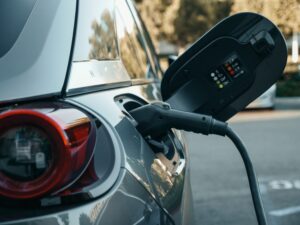
Electric vehicle (EV) adoption comes with many advantages including reduced emissions, less maintenance and a quieter ride. However, you might wonder how much it will cost to reap these rewards.
Is it true that it costs less money to charge an EV than to fuel a gas engine? Let’s check out some real-world situations and costs for charging an electric vehicle, and uncover the financial benefits of this type of automotive power.
There are three common ways of charging an EV: at home, at a Level 2 (L2) station and through Direct Current Fast Charging (DCFC). Here’s how they add up!
This is the most affordable and best way to charge your EV. Leaving it plugged in overnight at home is cost effective as well as charges the battery gradually which is easier on the electrical system.
Electric costs throughout the country vary, but we’ll use the California rate from the United States Energy Information Administration for our example. In California, the average residential cost of electricity is 29.78 cents per kilowatt-hour (kWh), though generally nighttime and overnight rates are lower. Each battery pack has a different capacity, so for our example we’ll use the Hyundai IONIQ 6, which comes standard with a 53 kWh battery. This provides an all-electric range of 240 miles. To bring the charge from empty to full, that would be approximately $15.78.
Keep in mind, you won’t need to charge your battery every night just as you don’t need to fill up at the pump every day. Depending on your commute, you might be able to drive a week (or more) without needing to charge.
Compare that to filling up at the pump. AAA shows that the average price for a gallon of regular gas in California is $5.09. Even if your vehicle has a small, 12-gallon tank, you’re looking at $61.08 to fuel up, and it’s likely that your car will have a larger gas tank capacity.
All of this math is to say that charging an EV at home is incredibly cost effective.
L2 charging is what you find at most public stations, and you can have an L2 charger installed at your home if you choose. That can be costly but might be worth it if you plan on staying in your home for a long time and own more than one EV.
L2 charging provides a bit faster charge, but since this is out at a public filling station or at a shopping center, can cost more. It’s estimated that California drivers can expect to pay 30 cents per kWh at L2 charging stations. Using our IONIQ 6 example above, that means that from empty to full, it would be approximately $15.90. However, this could take several hours, just as charging at home takes time. Not a big deal if you’re parking for an extended time to run some errands and enjoy a meal or a movie, but worth noting that there is a time investment here.
The final option would be to seek out a DCFC station, which can fill a vehicle up to 80% range in 15-20 minutes. While incredibly convenient, fast charging is hard on the EV’s battery, so you would want to reserve this type of charging for only certain occasions such as road trips or emergencies.
Electrify America, one of the bigger DCFC station providers, says that without a membership, it is 48 cents per kWh. For our IONIQ 6, that would be $25.44 to charge up. Even with the jump in pricing, this is still less money than filling up at the pump.
The benefits to owning an EV are numerous, including the low cost of charging. Compared to current gas prices, it is much more affordable to charge an EV than it is to fill up with fuel at a gas station. Those that can regularly charge a vehicle overnight at home, or have the time to use an L2 station while out and about, will have the lowest costs of charging as well as protect the battery pack and boost longevity.
Contact the any of our dealerships at Ontario Auto Center to learn about available EVs and anticipated charging costs specific to that vehicle.
While great effort is made to ensure the accuracy of the information on this site, errors can occur. Please verify all pricing and installed equipment information with a customer service representative. This is easily done by calling us or visiting us at the dealership.
Customer may not qualify for ALL Rebates shown. Some rebates are stackable and others can and cannot be combined. See Dealer For Complete Details.
We improve our products and advertising by using Microsoft Clarity to see how you use our website. By using our site, you agree that we and Microsoft can collect and use this data. Our privacy statement has more details.